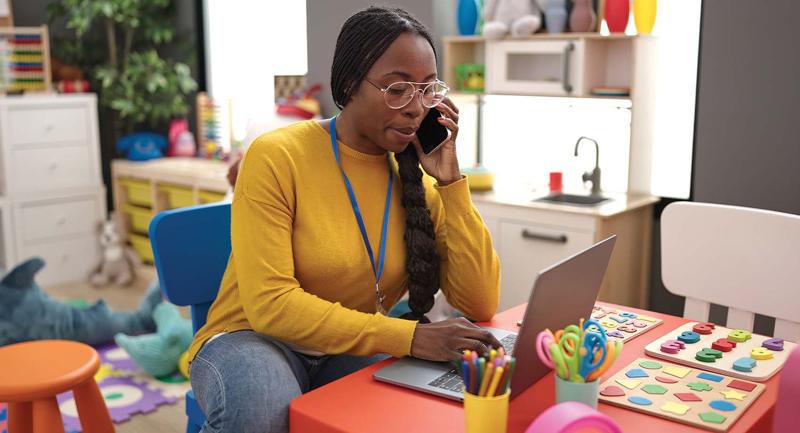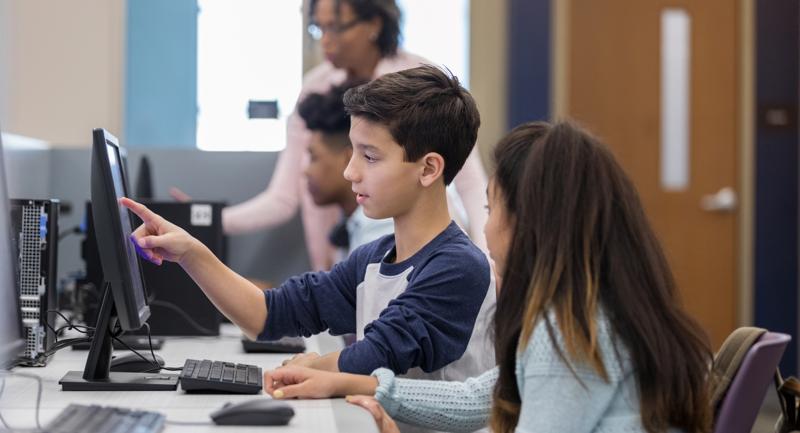Mention the best way for educators to prepare children for the future, and the conversation will nearly always come around to technology. As blogs light up with lively conversations about iPads, netbooks, and smart phones, it's easy to forget one major roadblock to preparing all children for the future: the digital divide.
Most middle-class children have home computers and can access the Internet. Not so for many children from low-income neighborhoods. This unequal access has serious implications for the growing chasm between low- and middle-income students. As a Pew Foundation report found, many children are using out-of-school time to refine their technology skills (Levin, Arafeh, Rainie, & Lenhard, 2002). This is fine for children from middle-class homes with a home computer, but what about the millions of children who are not from such homes?
Data from the 2000 U.S. Census reveal that half of children coming from homes with annual family incomes of $75,000 or above owned home computers, but just 15 percent of those with incomes between $20,000 and $25,000 did (National Center for Education Statistics, 2005). Internet connectivity is also an issue. Overall, 65 percent of all Americans have broadband connections in their homes. Among those Americans who make less than $25,000, 65 percent lack broadband access (Dailey, Bryne, Powell, Karaganis, & Chung, 2010).
If low-income children want to use a computer for a research assignment or merely to wander around on the Internet, they often must rely on the public library, after-school programs, or community organizations. This safety net, however, is full of holes. Economically disadvantaged children face tremendous challenges in accessing technology, and these challenges could affect school readiness and achievement as one group of children comes to school each day with superior technology skills and an ever-growing knowledge base, while the other group lags behind.
Haves and Have Nots
To understand the problem, let's look at two 5th grade girls from different Philadelphia schools. Olivia, a spunky 11-year-old with tight, curly hair, lives with her parents and two brothers on a tree-lined street of neat, older homes. The computer and Internet are big parts of Olivia's life. If she forgets her math homework, she goes to a website to print out the problems or e-mails her teacher for help. During the past year, she worked on a variety of school projects using her home computer: She developed a brochure for a science project, she researched the life of a French explorer, and she looked at footage from a webcam on the school roof to check the weather.
When not working on school projects, Olivia is free to search the Internet. She has a few favorite websites, and she has been noodling around with applications such as Skype. Because she must share the computer with her two brothers, school-related projects get top priority, so she cannot spend much time on "fun" things. Still the computer is there, sitting in a converted sun porch right off the kitchen. Among Olivia and her two brothers, it is in constant use most nights and weekends.
A few miles away, we find Tina, a soft-spoken 11-year-old with braids. Tina's neighborhood is a series of row homes, some inhabited, some abandoned, surrounded by poverty, high crime rates, and violence. We met up with Tina at the Salvation Army afterschool program she attends.
The computer is not nearly as big a part of Tina's life as it is Olivia's. Tina's teacher assigns little more than a worksheet or two for homework each night. It's hard, after all, to expect the many students in Tina's class without access to a home computer to complete research assignments for homework. Tina has a computer at home, but it is currently broken, and even when working it only has dial-up access. She spends about 10 hours a week here at the Salvation Army, where she sometimes uses one of six computers available to students in her after-school program. She must, however, share with the 30 to 75 other children who attend each day. In addition, the computers are housed in an office far from the main program rooms, and they are kept locked up to prevent vandalism.
When Tina does get online, she likes to play a few games—Fun Math for Kids or Study Island, two programs designed to enrich her school experience—but she isn't free to roam the Internet as she would like. First, there are the filters, which prevent her from exploring inappropriate websites but also make it hard to navigate. There is also the time issue: She can use computers only when teachers are present and usually for only about 30 minutes.
We have spent a great deal of time in Tina's world, exploring the availability of technology resources as part of a case study of an urban neighborhood in North Philadelphia, where poverty rates hover at around 65 percent. We have visited or phoned all the public libraries, recreation centers, after-school programs, and community organizations in the neighborhood that might offer technology access to students after school. We found strong signs that the digital divide is far from closed.
Lack of Computers
Tina's after-school program at the Salvation Army is actually one of the luckier ones. Many programs serving children outside school do not have any computers. For the 7,700 children ages 5–18 in this community, we counted 128 computers in 12 programs. That comes down to .017 computers for each child.
A substantial number of those computers—23—were housed in the two local library branches. Libraries offer an enormous service to the community, providing computers, Internet access, books, and other informational materials. Without the local libraries, the computer access rate would go down to .014 computers for each child. A child visiting the library, however, faces tremendous challenges. First, he or she must vie with the increasing number of adults seeking computer access. Waits of three hours are not uncommon. Then, time limits are often set at 30 minutes, barely enough time to research or write a school report.
One day in a branch of the Free Library of Philadelphia we found Angelica, a 7th grader, sitting on a bench watching the clock. She has a folder and a notebook on her lap; her legs swing back and forth as she silently waits for her 5:30 computer time. She is here to do research on the Internet for a Black History Month assignment due in a few days. Angelica has a computer at home, but it was stricken with a virus and has been out of commission for several months. When she arrived at the library today, the only computer time was 5:30; with the branch closing at 6:00, she has little time to work.
Because Angelica has limited computer experience, she has trouble typing. She eventually finds an article about Mary Macleod Bethune. She also needs a picture of Bethune, but she needs help figuring out how to find one. With five minutes to go, she tries to print, but there is no paper in the printer. "The library is closing in five minutes," the security guard booms over the intercom. Angelica sighs, resigning herself to coming back tomorrow and starting the process all over again.
It is worth noting that four of the five organizations with no computer access are after-school programs in local elementary schools. Each school has a computer lab, but children in afterschool programs are denied access. Gloria, the director of one program, says, "I have 5th and 6th graders who want to do research projects, but they can't use the computers here at the school," she says. "I need to send them to the local library instead. It's a dangerous walk, and it would be so much better if we had computers here."
Outdated and Unused Technologies
For children enrolled in after-school or other programs, computer availability increases —ally, from .01 to .12 computers per child. Availability, however, does not always translate into computer use. As we saw at the Salvation Army, computers are often locked away, preventing access. Computers are a precious commodity, after all, and the fear of theft is real.
More than theft, however, is the question of upkeep. Our visit to Taller Puertoriqueño, a community organization devoted to promoting Puerto Rican culture, illustrates the difficulty. Housed in a typical corner row house emblazoned with colorful mosaics and murals depicting Puerto Rican culture, Taller Puertoriqueño offers an array of services to the community, including art, dance, and theater programs; afterschool and summer camps; and teen graphic design courses.
Sandra, the program director, showed us two areas where computers are available for children's use. The first room, housed off the "homework club" area of the after-school program, is a cozy room with four relatively up-to-date computers and monitors. The children may use the computers only if they have a homework assignment requiring research or on Fridays during a free-choice period. "But," Sandra says, "we need to be careful. Someone needs to sit in here and supervise them." With no Internet filters, some children "download things they should not download. Then we get viruses and have problems."
With enrollment ranging from 20 to 75 students, it's often difficult to get one of the two or three teachers to sit in the computer room. It's much easier to do an art project or run a dance class that will involve all the children. In addition, the organization has little money for technical support or new equipment.
In the adjacent art room, teens are working on graphic design projects on one of two computers. Here we find Anna, age 15, assisted by Bob, the youth program leader. They are trying to incorporate a picture into Anna's graphic arts project but aren't making much progress. Sandra shakes her head sadly. "We don't have money to upgrade these computers so students can do their projects properly. That computer was fine two years ago, but now it doesn't have enough memory. We also have printers, but they break, or we can't afford the cartridges."
In many after-school programs, computer use is sporadic, dictated less by children's needs and more by the organization's limited resources. Computers are not like books. Certainly, books may become out-of-date or break down from wear and tear. For the most part, though, books are durable. Not so with computers: They get viruses and stop working. They become obsolete relatively quickly. Printers need expensive cartridges. Technical support is hard to come by and expensive. Of course, students could continue to access information through books, as in the past, but this will not help them develop the technological savvy they will need in the future.
High Interest, Limited Opportunity
Although computer access is noticeably lacking in this community, what is clearly abundant is interest. This was evident at Education Works, a community organization offering afterschool programs in elementary schools, day-care facilities, and job-training programs. Upstairs in the program's main building, housed in a converted factory on a busy corner, is a classroom containing six relatively new computers, all in good working order and easily accessible. Because this program is housed in the organization's main building, the site has on-site technical support staff to keep the computers running smoothly. "If I have a problem with a computer or printer," says Karen, the bubbly afterschool director, "I just call Ed. He'll come right up and fix it."
The 20 students here in the middle school classrooms may use a computer once their homework is complete. If they have an assignment requiring research, they may get on earlier. Today, all homework has been finished; one teen is checking out sneakers on a retail website, another is playing a game, and another is watching a movie trailer. Every seat is taken, and other students are waiting patiently for their turn. Even though computers are accessible, the children who attend Education Works still lag in opportunities that middle-income children experience daily. Only about 35 percent of the students here have Internet access at home; the others must get their computer access at Education Works or fight for a seat at the local library.
Even when computer access is equal, its use is different in different communities (Celano & Neuman, 2008; Neuman & Celano, 2006). Middle-income children start using computers at a younger age and get more adult assistance. Economically disadvantaged children tend to use computer time more for entertainment than do their middle-class peers, who use it more for information gathering. Over time, the differences accumulate, meaning that middle-class children will zoom ahead and low-income children will be left behind. What started as a gap will grow into a chasm.
Teachers also use computers differently in high-poverty areas. They don't e-mail students or use course or teacher web pages as much. Students are less likely to use class time to prepare written text or create multimedia presentations on the computer (Gray, Thomas, & Lewis, 2010). In TheDigital Disconnect, a Pew Foundation study, students report that teachers often will not assign projects requiring Internet access if many students do not have home computers. Students with limited technology resources miss out on opportunities to use the Internet as a virtual tutor or study group, as a guidance counselor, or as a notebook to store notes and resources for future reference (Levin, Arafeh, Rainie, & Lenhard, 2002).
Closing the Divide
Schools in low-income neighborhoods must help their students keep up with their more advantaged peers. Quite simply, low-income children need greater access to technology in school to make up for their limited access at home. Schools could, for example, allow access to school computer labs during evenings, weekends, and summers so that students could complete assignments or simply gain more experience exploring technology.
More important than simply offering access, though, schools need to provide low-income children with more opportunities to use technology to its fullest capacity. This includes focusing less on using computers to practice basic skills and more on teaching students strategic ways to use the computer. Many information websites, for example, will introduce students to interactive features they do not find in books and conventional print. The hyperlinks may encourage readers to navigate their own nonlinear paths through the information. Readers need to understand the advantages and disadvantages of following certain links and to discern one type of link from another. We need to integrate computers into classroom instruction as well as content-driven work.
In addition, we need to focus efforts on creating more complex in-school assignments that encourage students to use computers more effectively. Teachers can invite readers to coauthor online texts as they navigate various paths through information. Or students can use digital tools to interact with others and gain access to different perspectives. Finally, schools need to collaborate more closely with local libraries and after-school programs to ensure that computers are used efficiently to complete homework and other research assignments.
The first step, though, is recognizing that the digital divide still exists. Left unchecked, it will merely keep growing. Without equal access to technology, a large number of children face the future with little hope of keeping up in today's increasingly complex world.









